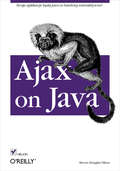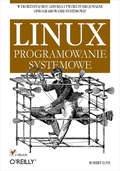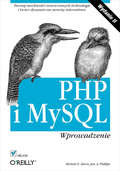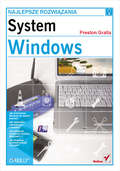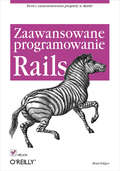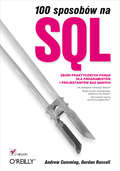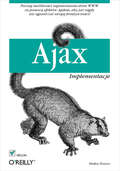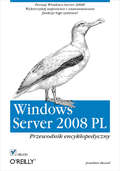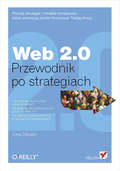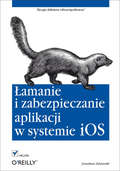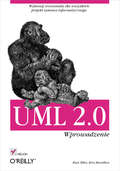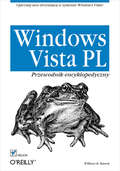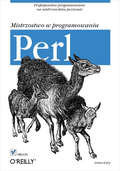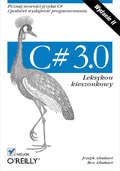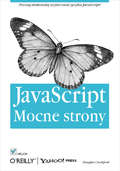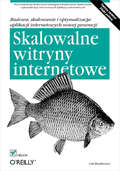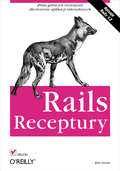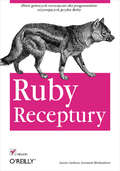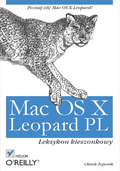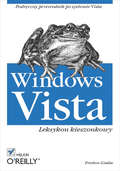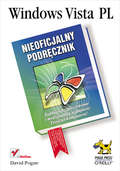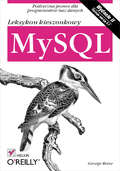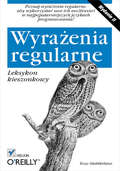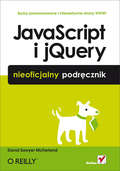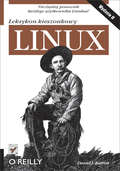- Table View
- List View
Ajax on Java
by Steven Douglas OlsonTwoje aplikacje jeszcze bardziej interaktywne! Jak integrowa? funkcje Ajaksa z aplikacjami JSP? Jak korzysta? z dost?pnych bibliotek znaczników i tworzy? w?asne? Jak ?šczy? techniki Ajax i Struts? Technologia Ajax oparta na kodzie Java gwarantuje uzyskanie prawdziwej interaktywno?ci witryny internetowej, wysoce komfortowej zarówno dla u?ytkownika, jak i jej administratora. Wielo?? zestawów narz?dziowych i technik umo?liwia maksymalne uproszczenie i przyspieszenie pracy webmastera. Zaimplementowanie Ajaksa w aplikacjach pisanych w j?zyku Java pozwala na uzyskanie niemal wszystkich efektów potrzebnych do sprawnego funkcjonowania dynamicznej strony WWW bez konieczno?ci wykorzystywania innych technologii. Ksiš?ka "Ajax on Java" to wprowadzenie do technologii Ajax, które pokazuje, jak wzbogaca? o funkcje ajaksowe aplikacje oparte na serwletach, aplikacje JSP, JSF i inne. Dzi?ki temu podr?cznikowi nauczysz si? tworzy? bardziej interaktywne, dynamiczne i efektowne strony internetowe poprzez wyeliminowanie pracoch?onnego wpisywania danych przez u?ytkownika i irytujšcego oczekiwania na od?wie?enie strony. Poznasz równie? kilka sposobów organizowania komunikacji pomi?dzy klientem a serwerem, w tym wykorzystanie formatów JSON, umo?liwiajšcych przesy?anie danych o bardziej z?o?onej strukturze. Krótko mówišc, ksiš?ka "Ajax on Java" podniesie Twoje umiej?tno?ci programowania na wy?szy poziom. Budowanie i instalowanie aplikacji Ajax Integrowanie funkcji Ajax z aplikacjami JSP Metody tworzenia dokumentów XML Tworzenie biblioteki znaczników Pobieranie i instalowanie biblioteki Ajax Pisanie kodu JSP z wykorzystaniem Struts-Layout Konfigurowanie serwletów Wykorzystywanie zestawu narz?dziowego GWT Wyszukiwanie b??dów w kodzie aplikacji Ajax on Java -- komfort webmasterów i u?ytkowników!
Linux. Programowanie systemowe
by Robert LoveWykorzystaj moc Linuksa i twórz funkcjonalne oprogramowanie systemowe!Jak zarz?dza? plikowymi operacjami wej?cia i wyj?cia?Jak zablokowa? fragmenty przestrzeni adresowej?Jak sterowa? dzia?aniem interfejsu odpytywania zdarze??Dzisiaj systemu Linux nie musimy ju? nikomu przedstawia?, dzi?ki swojej funkcjonalno?ci i uniwersalno?ci sta? si? niezwykle popularny i szeroko wykorzystywany. Dzia?a wsz?dzie ― poczynaj?c od najmniejszych telefonów komórkowych, a na pot??nych superkomputerach ko?cz?c. Z Linuksa korzystaj? agencje wywiadowcze i wojsko, jego niezawodno?? doceni?y równie? banki i instytucje finansowe. Oprogramowanie z przestrzeni u?ytkownika w systemie Linux mo?e by? uruchamiane na wszystkich platformach, na których poprawnie dzia?a kod j?dra.Czytaj?c ksi??k? "Linux. Programowanie systemowe", dowiesz si?, jak utworzy? oprogramowanie, które jest niskopoziomowym kodem, komunikuj?cym si? bezpo?rednio z j?drem oraz g?ównymi bibliotekami systemowymi. Opisany zosta? tu sposób dzia?ania standardowych i zaawansowanych interfejsów zdefiniowanych w Linuksie. Po lekturze napiszesz inteligentniejszy i szybszy kod, który dzia?a we wszystkich dystrybucjach Linuksa oraz na wszystkich rodzajach sprz?tu. Nauczysz si? budowa? poprawne oprogramowanie i maksymalnie je wykorzystywa?.Programowanie systemoweBiblioteka j?zyka CKompilator j?zyka CInterfejs odpytywania zdarze?Zarz?dzanie procesami i pami?ci?U?ytkownicy i grupyOgraniczenia zasobów systemowychZarz?dzanie plikami i katalogamiIdentyfikatory sygna?ówStruktury danych reprezentuj?ce czasKonwersje czasu Poznaj i ujarzmij pot?g? Linuksa!
PHP i MySQL. Wprowadzenie. Wydanie II
by Michele E. Davis Jon A. PhillipsPoznaj mo?liwo?ci nowoczesnych technologii i twórz dynamiczne serwisy internetowe Jak sprawdzi? poprawno?? danych i obs?ugiwa? b??dy?Jak zapisywa? nazwy u?ytkowników i has?a w bazie danych?Jak tworzy? zapytania do bazy danych za pomoc? funkcji PHP?PHP i MySQL to ju? standardowe technologie do tworzenia dynamicznych stron internetowych wykorzystuj?cych bazy danych. Istotne jest, ?e zapewniaj? one nie tylko interaktywno??, ale równie? wysoki stopie? bezpiecze?stwa witryn WWW. Ich ogromne mo?liwo?ci powoduj?, ?e wykorzystywane s? do tworzenia zarówno prostych aplikacji, jak i skomplikowanych stron internetowych, zaopatrzonych w rozbudowane systemy autoryzacji, na przyk?ad ró?nego rodzaju sklepy internetowe. Po??czenie PHP i MySQL stanowi wi?c niezast?pione narz?dzie do tworzenia dynamicznych witryn, spe?niaj?cych wymagania zarówno administratorów, jak i u?ytkowników.Ksi??ka "PHP i MySQL. Wprowadzenie. Wydanie II" przedstawia krok po kroku zasady tworzenia serwisów WWW z wykorzystaniem baz danych. W podr?czniku na przyk?adach przedstawiono m.in. sposoby pracy z baz? danych MySQL, serwerem WWW Apache czy j?zykiem PHP i XHTML. Czytaj?c t? ksi??k?, nauczysz si? przeprowadza? operacje na danych, zarz?dza? sesjami i tabelami oraz tworzy? zapytania. "Learning PHP &My SQL" stanowi niezb?dny podr?cznik zarówno dla pocz?tkuj?cych Czytelników, jak i programistów, którzy mieli wcze?niej do czynienia z j?zykiem HTML, a teraz chc? tworzy? dynamiczne i bezpieczne strony internetowe.Tre?? generowana dynamicznie i InternetPodejmowanie decyzji w PHPFunkcje i tablicePobieranie danych z kilku tabelPraca z baz? danych MySQLOperatory logiczneWspó?praca PHP i MySQLFormularze siecioweXHTMLPliki cookie, sesje i kontrola dost?puModyfikowanie obiektów MySQL i danych PHPOto ca?a, aktualna wiedza, której potrzebujesz, aby tworzy? interaktywne strony WWW.
System Windows. Najlepsze rozwi?zania
by Preston GrallaSystem Windows. Najlepsze rozwišzania Jak dopasowa? Windows do swoich potrzeb? Jak optymalnie zabezpieczy? komputer?Jak zwi?kszy? wydajno?? systemu Windows?Jak zbudowa? domowe centrum rozrywki? Systemu Windows nie trzeba nikomu przedstawia?. Warto jednak zobaczy?, jak mo?na go udoskonali? i dostosowa? do swoich potrzeb. Dzi?ki tej ksiš?ce poznasz szerokie spektrum oprogramowania -- zarówno wbudowanego, jak i zewn?trznego, wraz z instrukcjami u?ycia -- przeznaczonego do modyfikacji oraz personalizacji obecnie u?ywanych systemów Windows. Ksiš?ka "System Windows. Najlepsze rozwišzania" nie jest skierowana do tych, którzy oczekujš zwyk?ych porad i wskazówek mówišcych, gdzie nale?y kliknš?, gdzie przecišgnš? myszš i jakie polecenia wpisa?. To propozycja kreatywnych rozwišza?, dzi?ki którym ka?dy u?ytkownik b?dzie móg? dostosowa? ten system operacyjny i wszystkie aplikacje oraz sprz?t, na którym dzia?ajš, w celu podniesienia komfortu i wydajno?ci swojej pracy. Po przeczytaniu tej ksiš?ki samodzielnie skonfigurujesz interfejs Aero w systemie Vista i utworzysz w?asne gad?ety paska bocznego, po czym uruchomisz je z nap?du USB. Dzi?ki szczegó?owym instrukcjom i wskazówkom krok po kroku zastosujesz przedstawione tu sposoby na optymalizacj? pracy z Windows. Znajdziesz tu równie? porady dotyczšce przeglšdarki Internet Explorer i pakietu biurowego Office 2007 oraz sprz?tu, takiego jak Zune czy router bezprzewodowy. W ksiš?ce znajdziesz sposoby m. in. na: szybsze uruchamianie i zamykanie systemu,wyszukiwanie i zarzšdzanie plikami w Eksploratorze Windows,rozwišzywanie problemów z Internet Explorerem,k?opoty z sieciš,optymalizacj? poczty elektronicznej,zapewnianie bezpiecze?stwa i kontroli kont u?ytkowników,wykorzystanie grafiki i multimediów, podnoszenie wydajno?ci systemu.Uwolnij ca?y potencja? drzemišcy w systemie Windows!
Rails. Zaawansowane programowanie
by Brad EdigerTwórz zaawansowane projekty w Rails!Jak zadba? o bezpiecze?stwo?Jak zapewni? wydajno?? Twojej aplikacji?Jak stworzy? i utrzyma? du?y projekt w Rails?Ruby on Rails przebojem wdar? si? na rynek szkieletów aplikacji internetowych. Stworzony w architekturze MVC z wykorzystaniem popularnego j?zyka Ruby, zosta? entuzjastycznie przyj?ty przez spo?eczno?? programistów. G?ówne za?o?enia autora tego projektu, Davida Heinemeiera Hanssona, to szybko??, ?atwo?? i przyjemno?? tworzenia kodu. Ruby on Rails jest dojrza?ym rozwišzaniem, wykorzystywanym przez wiele firm w aplikacjach internetowych, tworzonych pod kštem ich specyficznych potrzeb. Liczba aplikacji, które powsta?y z wykorzystaniem tego szkieletu, ?wiadczy o jego wysokiej jako?ci oraz niewštpliwie ma wp?yw na wzrost popularno?ci samego j?zyka Ruby."Rails. Zaawansowane programowanie" porusza te tematy, które Wy, programi?ci, lubicie najbardziej! Dzi?ki tej ksiš?ce dowiesz si?, w jaki sposób wykorzysta? gotowe wtyczki oraz jak stworzy? nowe. Nauczysz si? stosowa? zaawansowane funkcje bazy danych oraz pod?šcza? si? jednocze?nie do wielu baz. Po lekturze tego podr?cznika bez problemu zapewnisz swojej aplikacji najwy?szy poziom bezpiecze?stwa, optymalnš wydajno?? i skalowalno??. Autor wskazuje tutaj równie? niezwykle interesujšce kwestie, dotyczšce projektowania du?ych aplikacji, wykorzystania systemów kontroli wersji oraz utrzymywania w?a?ciwej struktury projektu.Przypomnienie i omówienie podstawowych elementów Ruby i RailsStosowanie ActiveSupport oraz RailTiesZastosowanie i projektowanie wtyczekZaawansowane wykorzystanie baz danychUwierzytelnianie za pomocš LDAPBezpieczne szyfrowanie hase?Bezpieczne przetwarzanie formularzy i danych u?ytkownika Zapewnienie wydajno?ciSkalowanie architekturyWykorzystywanie us?ug WebTworzenie wieloj?zycznych aplikacjiZarzšdzanie du?ymi projektamiU?ywanie systemów kontroli wersjiPoznaj wszystkie funkcje Ruby on Rails!
100 sposobów na SQL
by Andrew Cumming Gordon RussellZbiór praktycznych porad dla programistów i projektantów baz danych Jak obs?ugiwa? ró?ne typy danych? W jaki sposób optymalizowa? wydajno?? baz danych? Jak budowa? raporty za pomoc? j?zyka SQL? Jeste? programist?, któremu przypad?o w udziale opracowanie aplikacji bazodanowej? Szukasz sposobu na zoptymalizowanie dzia?ania zapyta? SQL? A mo?e zastanawiasz si?, w jaki sposób sprawnie zarz?dza? kontami u?ytkowników bazy danych? J?zyk SQL to pot??ne narz?dzie, którego opanowanie pozwoli Ci na sprawne poruszanie si? w g?szczu tabel ka?dej bazy danych. Za pomoc? odpowiednio sformu?owanych instrukcji mo?na manipulowa? danymi, zarz?dza? kontami u?ytkowników i generowa? raporty. Jednak, pomimo stosunkowo niewielkiej ilo?ci polece?, j?zyk SQL kryje w sobie wiele zawi?o?ci. Dzi?ki ksi??ce "100 sposobów na SQL" nie b?dziesz musia? odkrywa? ka?dej z nich samodzielnie. W ka?dym z rozdzia?ów znajdziesz praktyczne porady i sposoby rozwi?zywania typowych zada? programistycznych zwi?zanych z bazami danych i j?zykiem SQL. Poznasz podstawy j?zyka, dowiesz si?, w jaki sposób przetwarza? ró?ne typy danych i korzysta? z symboli zast?pczych. Nauczysz si? tworzy? aplikacje sieciowe, optymalizowa? wydajno?? tabel i zapyta? SQL oraz tworzy? raporty. Przeczytasz ponadto o administrowaniu serwerem bazy danych i udost?pnianiu tabel u?ytkownikom. Podstawowe elementy j?zyka SQL ??czenie tabel Przetwarzanie danych tekstowych Operacje na liczbach i datach Bazy danych w aplikacjach sieciowych Zapytania niezale?ne od tabel Maksymalizowanie wydajno?ci zapyta? Tworzenie raportów Administrowanie kontami u?ytkowników Udost?pnianie informacji Zosta? ekspertem w programowaniu baz danych!
Ajax. Implementacje
by Shelley PowersPodš?aj za swojš wyobra?niš i usprawniaj strony www za pomocš efektów Ajaksa! Jak u?ywa? kodu JavaScript do rozwišzywania problemu niestandardowych atrybutów? Jak ?šczy? funkcje obs?ugi zdarze?? Jak tworzy? zaawansowane efekty bazujšce na CSS? Ajax to co? wi?cej ni? zbiór technologii obejmujšcy j?zyki oparte na znacznikach, jest bowiem narz?dziem, które -- ewoluujšc -- na bie?šco dotrzymuje kroku rozwijajšcej si? technice informatycznej, a tak?e wyobra?ni programistów. Po zastosowaniu stopniowego usprawniania mo?na dodawa? nowoczesne efekty Ajaksa i w ten sposób przenosi? tradycyjne aplikacje sieciowe i ich funkcjonalno?? na wy?szy poziom. "Ajax. Implementacje" to ksiš?ka dla programistów, którzy majš do?wiadczenie w tworzeniu witryn internetowych i sš zainteresowani ulepszaniem istniejšcych ju? aplikacji. Czytajšc jš, nauczysz si?, jak zwi?ksza? mo?liwo?ci stron www poprzez dodawanie do nich efektów Ajaxa, dowiesz si?, jak korzysta? z j?zyka SVG oraz obiektu Canvas. Poznasz jednš z najciekawszych mo?liwo?ci Ajaksa, czyli dodawanie us?ug sieciowych i ?šczenie danych bezpo?rednio na stronach internetowych na wiele ró?nych sposobów. "Ajax. Implementacje" zawiera ca?š niezb?dnš wiedz? potrzebnš, aby mie? nowoczesne i funkcjonalne strony www, nie budujšc ich od nowa. Stronicowanie w Ajaksie Strefa bezpiecze?stwa i zabezpieczenia j?zyka JavaScript Obs?uga zdarze? zgodna z Ajaksem System obs?ugi zdarze? Dojo i obiekty docelowe Dane dynamiczne Prawid?owe wspó?dzia?anie Ajaksa z innymi elementami aplikacji Efekty bibliotek zewn?trznych s?u?šce do obs?ugi danych Historia, nawigacja i miejsca w aplikacjach jednostronicowych Dodawanie zaawansowanych efektów wizualnych Witryny typu mashup Skalowanie, infrastruktura i tworzenie witryn od podstaw
Windows Server 2008 PL. Przewodnik encyklopedyczny
by Jonathan HassellPoznaj Windows Server 2008! Wykorzystaj najnowsze i zaawansowane funkcje tego systemu! Jak zainstalowa? Windows Server 2008 na wielu komputerach?Jak skonfigurowa? us?ugi serwera plików?Jak stosowa? zasady grup na powolnych ??czach sieciowych?Windows Server 2008 to system operacyjny nowej generacji. Pozwala on administratorom zmaksymalizowa? kontrol? nad infrastruktur?. Dzi?ki wprowadzonym zmianom (w stosunku do wersji Windows Server 2003) zapewnia wyj?tkow? dost?pno?? oraz du?e mo?liwo?ci zarz?dzania. System ten zosta? zaprojektowany jako najbardziej produktywna platforma dla zwi?kszaj?cych wydajno?? aplikacji i us?ug sieci Web. Nowa wersja wyposa?ona jest w zaawansowane funkcje zabezpiecze?, zdalny dost?p do aplikacji, mo?liwo?? centralnego zarz?dzania rolami serwera, mo?liwo?? monitorowania wydajno?ci i niezawodno?ci oraz wiele innych ciekawych narz?dzi.Ksi??ka "Windows Server 2008 PL. Przewodnik encyklopedyczny" proponuje Ci tylko to, co niezb?dne, aby? móg? dok?adnie zapozna? si? z aktualn? wersj? systemu oraz zdoby? praktyczne umiej?tno?ci. Podr?cznik ten zawiera procedury wykonywania podstawowych zada? administracyjnych oraz omówienia obszernych tematów, takich jak replikacja Active Directory, ochrona dost?pu do sieci czy klastry serwerów. Korzystaj?c z tej ksi??ki, poznasz nie tylko narz?dzia GUI, ale równie? narz?dzia wiersza polece?, które stanowi? znakomite uzupe?nienie zarz?dzania opartego na interfejsie graficznym. Pos?ugiwanie si? nimi pozwala na szybsz? prac? i jest koniecznym wst?pem do automatyzowania pracy przy u?yciu skryptów.Instalowanie systemuUs?ugi serwera plikówNarz?dzia wiersza polece?System DNSActive DirectoryReplikacja kataloguZasady grup i IntelliMirrorZabezpieczenia i aktualizacje systemu WindowsInternetowe us?ugi informacyjne -- wersja 7Windows Server 2008 Server CoreUs?ugi terminaloweProtokó? DHCP i funkcja -- ochrona dost?pu do sieciKlastry serwerówPowerShellTyper- VTylko to, co musisz wiedzie?, aby sprawnie korzysta? z systemu Windows Server 2008!
Web 2.0. Przewodnik po strategiach
by Amy ShuenPoznaj strategie i modele biznesowe, które podnios? wyniki finansowe Twojej firmy! Jak zarabia?, dostarczaj?c us?ugi za darmo?Jak stworzy? dochodowy biznes, oparty na Web 2.0?Jak w??czy? strategie Web 2.0 w istniej?ce przedsi?wzi?cie?Je?li my?lisz, ?e Web 2.0 to wy??cznie technologia budowy interaktywnych portali internetowych, jeste? w b??dzie. Web 2.0 to rewolucja! To nowy sposób komunikacji przez internet, umo?liwiaj?cy u?ytkownikom wspólne tworzenie witryny i dzielenie si? wiedz?. Dzi?ki efektom sieci Web 2.0 staje si? ?ród?em okazji biznesowych. Jest miejscem, gdzie zaawansowana technologia ??czy si? z biznesem i gdzie -- udost?pniaj?c us?ugi za darmo -- mo?esz zarabia?. Web 2.0 przyjmuje bowiem fundamentalnie odmienny punkt widzenia na relacje mi?dzy biznesem, klientami i partnerami, a wi?c udost?pnia nam wszystkim nowe modele biznesowe. Ksi??ka "Web 2.0. Przewodnik po strategiach" zawiera omówienie wszystkich potrzebnych w biznesie technik i narz?dzi analitycznych, co sk?ada si? na ogólny obraz ekonomii opartej na Web 2.0. Z tego podr?cznika dowiesz si?, jak powstaj? efekty sieci, w jaki sposób prowokowa? i wykorzystywa? okazje biznesowe oraz zarabia? pieni?dze na dostarczonych przez u?ytkowników warto?ciach. Uwierzysz, ?e za pomoc? Web 2.0 mog? bogaci? si? i korporacje, i niewielkie przedsi?biorstwa. Poznasz sprawdzone narz?dzia i strategie oraz rewolucyjne modele biznesowe, stosowane przez takie firmy, jak Google czy Amazon. Pami?taj, ?e tym firmom przynios?y one wielki sukces i ogromne zyski.Wspólna warto?? u?ytkowników portalu Odkrywanie i wykorzystywanie grup internetowychPozytywne efekty sieciowe w Web 2.0Spieni??anie sieci spo?ecznychKoszty pozyskania klienta i szybko?? wzrostu zysku z reklamTworzenie warto?ci w sieciach spo?ecznychRozwijanie zdolno?ci adaptacyjnych przez Web 2.0Style innowacjiTworzenie biznesplanów Web 2.0 Przy??cz si? do rewolucji Web 2.0 i zarabiaj w internecie Wyró?nienie Magazynu Literackiego KSI??KIRedakcja Magazynu Literackiego KSI??KI przyzna?a ksi??ce "Web 2.0 - przewodnik po strategiach" w kwietniu 2009 roku Wyró?nienie za ksi??k? miesi?ca w kategorii Ekonomia http://helion.pl/img/rozne/wyd/wyd7_6.jpg" />
?amanie i zabezpieczanie aplikacji w systemie iOS
by Jonathan ZdziarskiTwoja lektura obowi?zkowa!iOS to obecnie jeden z najpopularniejszych systemów operacyjnych, wykorzystywany w urz?dzeniach firmy Apple. Jednak dzi?ki tej popularno?ci jest on te? ?akomym k?skiem dla hakerów. Uzyskanie dost?pu do danych przechowywanych w telefonie mo?e mie? katastrofalne skutki. Dlatego je?eli tworzysz aplikacje na platform? iOS, ta ksi??ka jest dla Ciebie pozycj? obowi?zkow?. Jak obroni? si? przed atakiem? Wszystkie niezb?dne informacje znajdziesz w tym wyj?tkowym podr?czniku. W trakcie lektury dowiesz si?, jak dzia?aj? hakerzy, jak wyszukuj? s?abe punkty aplikacji oraz jak modyfikuj? jej kod. Ponadto nauczysz si? utrudnia? ?ledzenie kodu Twojej aplikacji oraz bezpiecznie usuwa? pliki (tak, aby nie by?o mo?liwe ich odtworzenie). W?ród poruszanych tematów znajdziesz równie? te zwi?zane z transmisj? danych: wykorzystanie protoko?u SSL to nie wszystko, musisz zadba? tak?e o to, ?eby nie by?o mo?liwe przej?cie sesji SSL. We? ksi??k? do r?ki i obro? si? przed atakiem!Dzi?ki tej ksi??ce:zrozumiesz, jak dzia?aj? hakerzyzabezpieczysz swoj? aplikacj? przez nieuprawnionymi zmianamiochronisz swoje bezpieczne po??czeniabezpowrotnie usuniesz niepotrzebne plikizagwarantujesz bezpiecze?stwo danych u?ytkownikom Twojej aplikacjiZadbaj o bezpiecze?stwo danych u?ytkowników Twojej aplikacji!
UML 2.0. Wprowadzenie
by Kim Hamilton Russ MilesNajtrudniejszym etapem ka?dego procesu tworzenia systemu informatycznego jest wykonanie odpowiedniego projektu. Umiej?tno?? pogodzenia wymaga? u?ytkowników i osób finansuj?cych system z mo?liwo?ciami oferowanymi przez technologi? jest kluczowym elementem sukcesu. Im bardziej z?o?ony system, tym bardziej zawi?y staje si? projekt. Konieczno?? ustandaryzowana technik projektowania systemów zaowocowa?a powstaniem narz?dzi, dzi?ki którym nawet najbardziej skomplikowany projekt mo?na przedstawi? w prosty i czytelny sposób. Takim narz?dziem jest notacja UML -- zestaw ikon tworz?cych diagramy opisuj?ce system i jego elementy. Ksi??ka "UML 2.0. Wprowadzenie" w praktyczny sposób przedstawia techniki modelowania systemów informatycznych za pomoc? j?zyka UML 2.0. Czytaj?c j?, nauczysz si? graficznie przedstawia? otoczenie systemu, wymagania stawiane przez u?ytkowników i metody ich implementacji w systemie. Utworzysz diagramy klas, interakcji, komponentów, wdro?enia i inne, które opisuj? projekt w jednoznaczny oraz prosty sposób. Dowiesz si? tak?e, jak zaplanowa? proces wdro?enia produktu za pomoc? UML. Elementy j?zyka UML Modelowanie wymaga? za pomoc? przypadków u?ycia Diagramy czynno?ci i sekwencji Modelowanie klas i powi?za? pomi?dzy nimi Diagramy komponentów Podzia? modelu na pakiety Modelowanie wdro?enia systemu Poznaj nowoczesne metody projektowania systemów informatycznych.
Windows Vista PL. Przewodnik encyklopedyczny
by William R. StanekUjarzmij moc drzemišcš w systemie Windows Vista! Jak zarzšdza? systemem i optymalnie go konfigurowa?? Jak przetwarza? media cyfrowe? Jak efektywniej przeszukiwa? zasoby komputera i nimi zarzšdza?? Windows Vista jest pierwszš wersjš systemu Windows, której funkcjonalno?? zmienia si? w zale?no?ci od komputera, a modu?owa budowa i uniezale?nienie od siebie poszczególnych sk?adników pozwalajš bardzo ?atwo dodawa? funkcje lub po prostu wy?šcza? poszczególne mechanizmy. Vista wprowadza wiele nowych mo?liwo?ci i praktycznych u?atwie?, takich jak przejrzysty i wygodny interfejs u?ytkownika, sprawna nawigacja, nowocze?niejsze zabezpieczenia, a dla osób obdarzonych wra?liwo?ciš estetycznš -- efektowne nowo?ci wizualne. "Windows Vista PL. Przewodnik encyklopedyczny" to nie jest zwyk?y podr?cznik. Dlaczego? Poniewa? jest to ksiš?ka przydatna na ka?dym poziomie zaawansowania. Przyda si? wszystkim tym, którzy ju? wcze?niej zetkn?li si? z tym systemem, a teraz chcš zaktualizowa? swojš wiedz?, pomo?e poczštkujšcym, a tak?e administratorom i pracownikom dzia?ów informatycznych. Przewodnik zawiera bowiem wszystko, co jest potrzebne, aby dopasowa? system operacyjny do indywidualnych potrzeb. Dzi?ki niemu dowiesz si?, jak zarzšdza? systemem i konserwowa? go, jak tworzy? biblioteki multimediów czy konfigurowa? urzšdzenia sprz?towe; poznasz te? wiele tajemnic, przydatnych trików i sztuczek do natychmiastowego wykorzystania, niezale?nie od u?ywanej edycji systemu. Konfiguracja systemu, sprz?tu i akcesoriów komputera Praca z danymi i mediami cyfrowymi Tworzenie biblioteki multimediów Zabezpieczanie i udost?pnianie danych Kompresowanie dysku Korzystanie z Centrum sieci i udost?pniania Ochrona komputera za pomocš Windows Defender i Zapory Windows Korzystanie z zasad grupy w systemie Windows Vista Konfigurowanie ustawie? proxy dla po?šcze? mobilnych Skróty klawiaturowe Zarzšdzanie repozytorium informacji BCD
Perl. Mistrzostwo w programowaniu
by Brian D FoyProfesjonalne programowanie na mistrzowskim poziomie Jak wykrywa? b??dy, których Perl nie raportuje? Jak pisa? programy jako modu?y? Jak ?ledzi? dzia?anie programu za pomoc? Log4perl? Perl jest j?zykiem o szerokim zastosowaniu, mo?na go skompilowa? na prawie wszystkich architekturach i systemach operacyjnych. Wszechstronno?? Perla pozwala na programowanie w ró?nych modelach: proceduralnym, funkcyjnym czy obiektowym. Jest doskona?ym narz?dziem do analizy plików tekstowych oraz tworzenia raportów, aplikacji, modu?ów i programów. Umo?liwia powi?zanie systemów i struktur danych, których wspó?praca nie by?a przewidywana w momencie projektowania. Twórcy Perla twierdz?, ?e j?zyk ten sprawia, i? rzeczy ?atwe pozostaj? ?atwymi, a trudne staj? si? mo?liwe do wykonania. "Perl. Mistrzostwo w programowaniu" to wyj?tkowa ksi??ka pomagaj?ca w samodzielnej nauce, przeznaczona dla programistów, którzy u?ywali ju? Perla i znaj? jego podstawy. Pod??aj?c za radami z tego przewodnika, nauczysz si? definiowa? procedury i odwraca? zwyk?y model programowania proceduralnego. B?dziesz wiedzia?, jak zapisywa? dane, aby wykorzysta? je w innym programie, a tak?e jak poprawia? kod bez modyfikowania pierwotnego kodu ?ród?owego. Dowiesz si? tak?e, jak u?ywa? operacji na bitach oraz wektorów bitowych do efektywnego przechowywania danych. Czytaj?c "Perl. Mistrzostwo w programowaniu", zmierzasz prost? drog? do mistrzostwa. Tworzenie i zast?powanie nazwanych procedur Modyfikowanie i rozszerzanie modu?ów Konfigurowanie programów Perla Rejestrowanie b??dów i innych informacji Utrwalanie danych Praca z formatem Pod Tworzenie podklas modu?u Pod::Simple Operatory bitowe Przechowywanie ?a?cuchów bitowych Testowanie programu Do??cz do klasy mistrzów -- twórz profesjonalne programy w Perlu!
C# 3.0. Leksykon kieszonkowy. Wydanie II
by Ben Albahari Joseph AlbahariPoznaj nowo?ci j?zyka C# i podnie? wydajno?? programowania.Co nowego w C# 3.0?Jak skróci? i usprawni? swój kod?Do czego s?u?y mechanizm LINQ?C# jest obiektowym j?zykiem programowania zalecanym przez Microsoft dla platformy .NET Framework. Pozwala definiowa? wiele ró?norodnych elementów sk?adowych klas, nie tylko pola czy metody. Analiza struktury kodu umo?liwia tworzenie wysoce uniwersalnych mechanizmów operuj?cych na strukturze kodu nieznanej w czasie kompilacji. Wiedza programisty jest kluczem do wykorzystania wszystkich jego mo?liwo?ci. Leksykon stanowi bogate kompendium nowych rozwi?za? dost?pnych w C# 3.0 oraz ich implementacji. Opisane zagadnienia, dotycz?ce mechanizmu LINQ (Language Integrated Query), pozwalaj? na pozyskanie praktycznej wiedzy niezb?dnej we wspó?czesnym programowaniu. Ksi??ka C# 3.0 Leksykon kieszonkowy. Wydanie II, poruszaj?ca w sposób przejrzysty i rzeczowy ca?o?? poj?ciowych zmian koniecznych do opanowania C#, jest idealn? pozycj? dla wszystkich programistów, którym nieobca jest Java, C++ lub poprzednie wersje C#.Do najwa?niejszych cech wyró?niaj?cych j?zyk C# w wydaniu 3.0 zaliczamy:wyra?enia lambda,metody rozszerzaj?ce,niejawne typowanie zmiennych lokalnych,sk?adni? ujmowania zapyta? w kodzie,typy anonimowe,niejawne typowanie tablic,inicjalizatory obiektów,w?a?ciwo?ci automatyczne,metody cz??ciowe, drzewa wyra?e?.Nie tra? czasu na szukanie informacji! Programuj wydajnie i efektywnie z kieszonkowym leksykonem!
JavaScript - mocne strony
by Douglas CrockfordPoznaj doskona?? u?yteczno?? j?zyka JavaScript!Jak efektywnie wykorzysta? najlepsze funkcje JavaScript?Jak pisa? programy, aby ustrzec si? b??dów?Jak zdefiniowa? podzbiór j?zyka i tworzy? idealne aplikacje?Warto pozna? j?zyk JavaScript, poniewa? stanowi on jedno z wa?niejszych narz?dzi w informatyce -- dzi?ki temu, ?e jest jednocze?nie podstawowym i domy?lnym j?zykiem przegl?darek internetowych oraz j?zykiem programowania. JavaScript pozwala na tworzenie wydajnego kodu bibliotek obiektowych czy aplikacji opartych na technice AJAX. Jego skrypty s?u?? najcz??ciej do zapewniania interaktywno?ci, sprawdzania poprawno?ci formularzy oraz budowania elementów nawigacyjnych. Do?? ?atwa sk?adnia sprawia, ?e pisanie pe?noprawnych i wydajnych aplikacji w tym j?zyku nie jest trudne nawet dla pocz?tkuj?cych programistów. Ksi??ka "JavaScript -- mocne strony" to wyj?tkowy podr?cznik do nauki tego popularnego, dynamicznego j?zyka programowania. Dowiesz si? z niej, jak efektywnie wykorzysta? wszystkie jego mocne strony (m.in. funkcje, dynamiczne obiekty, litera?y obiektowe) oraz jak unika? pu?apek. Poznasz elementy sk?adowe j?zyka oraz sposoby ich ??czenia, zrozumiesz, na czym polega dziedziczenie prototypowe, w jaki sposób brak kontroli typów ma pozytywny wp?yw na pisanie aplikacji oraz dlaczego stosowanie zmiennych globalnych jako podstawowego modelu programowania nie jest dobrym pomys?em. Znaj?c wszelkie ograniczenia j?zyka JavaScript, b?dziesz móg? profesjonalnie wykorzysta? jego najlepsze cz??ci.Gramatyka j?zyka JavaScriptObiekty i funkcjeRekurencjaKaskadowe ??czenie wywo?a?Litera?y obiektoweDziedziczenie -- pseudoklasyczne, prototypowe, funkcyjneTabliceWyra?enia regularneKlasa znaków i kwantyfikator wyra?enia regularnegoNie tra? czasu -- si?gaj tylko po to, co najlepsze w j?zyku JavaScript!
Skalowalne witryny internetowe. Budowa, skalowanie i optymalizacja aplikacji internetowych nowej generacji
by Cal HendersonNaucz si? tworzy? aplikacje internetowe nowej generacji i do?šcz do nurtu Web 2.0 Chcesz tworzy? bardziej wydajne aplikacje internetowe? Chcesz pozna? zasady projektowania skalowalnych architektur? Chcesz efektywnie zarzšdza? danymi w aplikacjach internetowych? Oblicze internetu podlega nieustannym zmianom. Obecnie coraz cz??ciej obok klasycznych witryn internetowych pojawiajš si? aplikacje internetowe, które charakteryzujš si? odseparowaniem warstwy danych od warstwy prezentacji. Zmiana modelu programowania wymaga przygotowania odpowiedniej platformy sprz?towej i programowej oraz zaprojektowania nowego systemu obs?ugi danych. Zastosowanie przy wykonywaniu tych zada? sprawdzonych strategii wykorzystywanych przez pionierów tworzšcych aplikacje internetowe nowej generacji pozwoli Ci zaoszcz?dzi? czas i koszty. Ksiš?ka "Skalowalne witryny internetowe..." to zaawansowany i wszechstronny przeglšd zagadnie? zwišzanych z budowaniem takich w?a?nie aplikacji internetowych. Pomo?e Ci ona w rozwišzaniu problemów i unikni?ciu pu?apek czyhajšcych na programistów witryn internetowych nowej generacji. Poznasz sprawdzone strategie projektowania architektury oprogramowania, przygotowywania ?rodowiska programistycznego, zapewniania niezawodno?ci aplikacji czy wydajnego zarzšdzania informacjami. Dowiesz si? tak?e, jak tworzy? skalowalne i ?atwe w konserwacji witryny, które b?dš zapewnia? komfort pracy niezale?nie od up?ywu czasu i wzrostu liczby u?ytkowników. Projektowanie architektury aplikacji internetowych Przygotowywanie ?rodowiska programistycznego Tworzenie aplikacji wieloj?zycznych Zarzšdzanie bazami danych Integrowanie poczty elektronicznej z witrynami Stosowanie us?ug zdalnych Wykrywanie i rozwišzywanie problemów z wydajno?ciš Skalowanie aplikacji internetowych Monitorowanie funkcjonowania aplikacji Korzystanie z interfejsów API
Rails. Receptury
by Rob OrsiniZbiór gotowych rozwišza? dla twórców aplikacji internetowych Instalacja i uruchomienie ?rodowiska Rails Przetwarzanie grafiki Korzystanie z technologii AJAX Dynamiczny rozwój sieci sprawia, ?e tradycyjne programy sš stopniowo wypierane przez aplikacje sieciowe dost?pne z poziomu przeglšdarki internetowej -- wygodne, niezale?ne od systemu operacyjnego i ?atwe w aktualizowaniu. Nadal jednak kluczowe znaczenie ma szybko?? ich przygotowywania i modyfikowania. Dzi?ki zbiorom bibliotek zwanym "frameworks" proces tworzenia takich produktów znacznie si? skróci? -- umo?liwia to programistom skoncentrowanie si? na faktycznej funkcjonalno?ci tworzonego narz?dzia, poniewa? biblioteki te przejmujš wiele typowych i wspólnych dla wszystkich aplikacji zada?. W?ród dost?pnych w sieci narz?dzi tego typu coraz wi?kszš popularno?? zyskuje Ruby on Rails, powoli stajšcy si? "ikonš" nurtu Web 2.0. Tworzone za jego pomocš systemy sš zwarte i ?atwe do skalowania, a ich kod ?ród?owy jest przejrzysty i czytelny. "Rails. Receptury" to zestaw porad i rozwišza? problemów, przed którymi stajš programi?ci stosujšcy ten zbiór bibliotek w swojej pracy. Omówione tu zagadnienia przydadzš si? zarówno poczštkujšcym, jak i do?wiadczonym twórcom aplikacji sieciowych. Przeczytasz tu o instalowaniu, konfigurowaniu i uruchamianiu ?rodowiska Rails, po?šczeniach z bazami danych za pomocš ActiveRecord, generowaniu kodu HTML, zabezpieczaniu programów i tworzeniu kontrolerów odpowiadajšcych za funkcjonalno?? systemu. Dowiesz si?, jak wdra?a? aplikacje Rails i korzysta? w nich z mo?liwo?ci oferowanych przez mechanizmy AJAX. Instalacja i uruchomienie ?rodowiska Komunikacja z bazami danych Wy?wietlanie danych w przeglšdarce Wykorzystywanie szablonów RHTML Generowanie kodu XML i RSS Przetwarzanie danych z formularzy Personalizacja narz?dzi Korzystanie z JavaScript i AJAX Zabezpieczanie aplikacji Rails Optymalizacja aplikacji Wdra?anie i utrzymywanie systemów na serwerach Przetwarzanie obrazów Skorzystaj ze sprawdzonych receptur i do?šcz do twórców Web 2.0!
Ruby. Receptury
by Lucas Carlson Leonard RichardsonZbiór gotowych rozwišza? dla programistów u?ywajšcych j?zyka Ruby Jak przetwarza? pliki XML i HTML? Jak wykorzystywa? ?rodowisko Ruby on Rails? W jaki sposób ?šczy? Ruby z technologiš AJAX? Korzystasz w pracy z j?zyka Ruby i zastanawiasz si?, czy niektóre zadania programistyczne mo?na wykona? szybciej? Chcesz pozna? zasady programowania obiektowego w Ruby? A mo?e interesuje Ci? framework Ruby on Rails? J?zyk Ruby zdobywa coraz wi?kszš popularno??, jest wykorzystywany do tworzenia aplikacji sieciowych i sta? si? podstawš ?rodowiska Ruby on Rails. Jednak nawet najlepszy j?zyk programowania nie uwalnia programistów od ?mudnego realizowania zada?, które nie majš zbyt wiele wspólnego z tworzeniem aplikacji, czyli usuwania b??dów, implementowania typowych algorytmów, poszukiwania rozwišza? mniej lub bardziej typowych problemów i wielu innych. Ksiš?ka "Ruby. Receptury" znacznie przyspieszy Twojš prac?. Znajdziesz tu kilkaset praktycznych rozwišza? problemów wraz z przejrzystym komentarzem oraz tysišce wierszy proponowanego kodu, który b?dziesz móg? wykorzysta? w swoich projektach. Przeczytasz o strukturach danych, algorytmach, przetwarzaniu plików XML i HTML, tworzeniu interfejsów u?ytkownika dla aplikacji i po?šczeniach z bazami danych. Nauczysz si? generowa? i obrabia? pliki graficzne, korzysta? z us?ug sieciowych, wyszukiwa? i usuwa? b??dy w aplikacjach, a tak?e pisa? skrypty niezwykle pomocne w administrowaniu systemem operacyjnym Linux. Przetwarzanie danych tekstowych i liczbowych Operacje na tablicach Praca z systemem plików Programowanie obiektowe Przetwarzanie dokumentów XML i HTML oraz plików graficznych Generowanie plików PDF Po?šczenie z bazami danych Korzystanie z poczty elektronicznej, protoko?u telnet i po?šcze? Torrent Projektowanie aplikacji internetowych za pomocš Ruby on Rails Stosowanie us?ug sieciowych Optymalizacja aplikacji Tworzenie wersji dystrybucyjnych Automatyzacja zada? z wykorzystaniem j?zyka Rake Budowanie interfejsów u?ytkownika Je?li chcesz rozwišza? problem, skorzystaj z gotowej receptury -- ko?o ju? wynaleziono.
Mac OS X Leopard PL. Leksykon kieszonkowy
by Chuck ToporekJak wykorzysta? narz?dzia dost?pne w MacOS X?Co nowego znajdziesz w najnowszej wersji Leopard?Jak zapewni? bezpiecze?stwo w MacOS X? Windows jest niezaprzeczalnie najpopularniejszym systemem operacyjnym na ?wiecie. Pytanie brzmi, czy najlepszym? A mo?e najlepszy jest Linux, a mo?e jednak MacOS X? Na to pytanie nie ma, nie by?o i nie b?dzie jednej odpowiedzi. Wszystkie te systemy majš zarówno swoich fanatycznych zwolenników, jak i zaciek?ych przeciwników. Jedno jest pewne, to w?a?nie MacOS X jest ?ród?em wszystkich innowacyjnych rozwišza? w interfejsie u?ytkownika. To w?a?nie on s?ynie ze swojej intuicyjno?ci, stabilno?ci i wydajno?ci. To w?a?nie MacOS X jest uznawany za najlepszy system dla grafików, projektantów i artystów. To w?a?nie on stanowi jedno z najlepszych alternatywnych rozwišza? dla domu i biura. Tym faktom nie mo?na zaprzeczy?!Je?eli znasz ju? ten system operacyjny, ta ksiš?ka b?dzie dla Ciebie ?wietnym leksykonem, pomagajšcym uporzšdkowa? wiedz? na temat MacOS X. Zyskasz mo?liwo?? zapoznania si? z funkcjami dost?pnymi w najnowszej wersji tego systemu, noszšcej nazw? Leopard. Je?eli za? chcesz dopiero pozna? ten system, nie mog?e? lepiej trafi?. Dzi?ki temu podr?cznikowi szybko zapoznasz si? z filozofiš systemu, zasadš dzia?ania jego interfejsu oraz jego mo?liwo?ciami. Ksiš?ka "MacOS X Leopard PL. Leksykon kieszonkowy" przedstawia obowišzujšce zasady bezpiecze?stwa, sposób konfiguracji systemu oraz dost?pne w nim narz?dzia. Sprawi ona, ?e zechcesz usiš?? do klawiatury i wykorzysta? mo?liwo?ci drzemišce w MacOS X Leopard!Nowo?ci w systemie MacOS X LeopardBezpiecze?stwo w systemie MacOS XWykorzystanie interfejsu u?ytkownikaNarz?dzia Finder, Exposé, WashboardKonfiguracja sieci bezprzewodowejZarzšdzanie czcionkamiDostosowywanie dzia?ania systemuWykorzystanie mo?liwo?ci BootCampSposoby aktualizacji oprogramowaniaRozwišzywanie problemów w systemie MacOS XDrukarki i drukowanieZmie? system operacyjny na lepszy!
Windows Vista. Leksykon kieszonkowy
by Preston GrallaPodr?czny przewodnik po systemie Vista Przeglšd najwa?niejszych elementów systemu Zestawienie skrótów klawiaturowych Omówienie struktury rejestru systemowego System operacyjny Windows Vista -- najnowsza wersja najpopularniejszego systemu operacyjnego -- wkroczy? na rynek z rozmachem. Od dawna zapowiadany produkt firmy Microsoft szybko sta? si? przebojem w?ród u?ytkowników komputerów. Producent zaoferowa? kilka wersji ró?nišcych si? mo?liwo?ciami, jednak majšcych wiele wspólnego. Vista ma nowy, bardzo intuicyjny i wygodny interfejs u?ytkownika, jest stabilna, bezpieczna i doskonale sprawdza si? w sieci. Narz?dzia, znane u?ytkownikom poprzednich wersji Windows, zosta?y gruntownie przeprojektowane i dodano wiele nowych. Ksiš?ka "Windows Vista. Leksykon kieszonkowy" to zwi?z?y przewodnik po tym nowatorskim systemie operacyjnym. Znajdziesz w nim niezb?dne do pracy wiadomo?ci podane w zwartej i czytelnej postaci. Poznasz najwa?niejsze elementy systemu oraz narz?dzia i aplikacje, w jakie zosta? wyposa?ony. Przeczytasz o korzystaniu ze skrótów klawiaturowych, pracy w sieci, modyfikowaniu zawarto?ci rejestru, wyszukiwaniu plików i danych, drukowaniu i systemie plików. Dowiesz si? tak?e, jak korzysta? z wiersza polece?. Elementy Pulpitu Dyski, foldery i pliki Skróty klawiaturowe Konfigurowanie systemu za pomocš Panelu sterowania Przeszukiwanie plików i folderów Korzystanie z poczty elektronicznej i przeglšdarki Internet Explorer Konfiguracja po?šcze? sieciowych Administracja systemem Edycja rejestru Polecenia konsoli tekstowej Dzi?ki tej ksiš?ce szybko zaczniesz efektywnš prac? z systemem Windows Vista.
Windows Vista PL. Nieoficjalny podr?cznik
by David PogueZadbaj o bezpiecze?stwo i maksymalnš wydajno?? Twojego komputera! Jak zabezpieczy? komputer przed wirusami, oprogramowaniem szpiegujšcym i co zrobi? z uszkodzonymi dyskami twardymi? Jak efektywnie segregowa?, filtrowa? i wyszukiwa? pliki? Do czego s?u?y galeria fotografii? Vista to najnowsza i bez wštpienia najbezpieczniejsza wersja sytemu operacyjnego Windows, zawierajšca mnóstwo mechanizmów i udogodnie? zapewniajšcych bezpieczne korzystanie z sieci oraz u?atwiajšcych optymalne u?ytkowanie Twojego sprz?tu. Wyposa?ony jest w nowoczesne narz?dzia, takie jak Defender, który zabezpiecza komputer przed programami szpiegujšcymi, oraz filtr oszuka?czych witryn ostrzegajšcy przed otwieraniem fa?szywych stron podszywajšcych si? na przyk?ad pod serwisy internetowe banków. System wprowadza te? mechanizmy kontrolne dla administratorów w przedsi?biorstwach oraz nowy program do tworzenia kopii zapasowych. "Windows Vista. Nieoficjalny podr?cznik" to ksiš?ka przydatna na ka?dym poziomie zaawansowania technicznego, zawierajšca opis podstawowych zagadnie? i komponentów oprogramowania, instrukcje korzystania z systemu oraz informacje o szybszych metodach wykonania ró?nego typu operacji, które przydadzš si? do?wiadczonym u?ytkownikom. Korzystajšc z "Nieoficjalnego podr?cznika", dowiesz si? mi?dzy innymi, do czego s?u?y zapora ogniowa, nauczysz si?, jak sprawnie tworzy? kopie zapasowe i budowa? w?asnš sie?. Znajdziesz tu wszelkie informacje potrzebne, by do maksimum wykorzysta? mo?liwo?ci systemu, a tak?e te, jak u?ywa? gad?etów -- mikroprogramów prezentujšcych na pulpicie na przyk?ad prognoz? pogody czy wyniki gie?dowe. Oprogramowanie Visty Konfiguracja kont internetowych Panel nawigacyjny, panel podglšdu i panel szczegó?ów Uk?adanie w stos, grupowanie, filtrowanie Programy multimedialne Rozpoznawanie mowy w systemie Windows Mechanizmy zabezpieczajšce Sprz?t i urzšdzenia peryferyjne Budowanie sieci Wszystko, co powiniene? wiedzie?, aby maksymalnie wykorzysta? mo?liwo?ci Visty!
MySQL. Leksykon kieszonkowy. II wydanie
by George ReeseMySQL to jeden z najpopularniejszych systemów zarz?dzania bazami danych. Rozprowadzany na zasadzie open source, MySQL jest wykorzystywany jako zaplecze bazodanowe setek tysi?cy serwisów WWW, sklepów internetowych, blogów i galerii. Coraz cz??ciej si?gaj? po niego tak?e twórcy rozbudowanych aplikacji korporacyjnych, poszukuj?cy stabilnej, bezpiecznej i wydajnej platformy do przechowywania danych. W najnowszej wersji, oznaczonej symbolem 5.0, dodano wiele od dawna oczekiwanych funkcji, w tym procedury sk?adowane, wyzwalacze, kursory i widoki. Poprawiono tak?e mechanizmy sk?adowania danych. Je?li jeste? administratorem lub programist? baz danych, ksi??ka "MySQL. Leksykon kieszonkowy. II wydanie" b?dzie dla Ciebie nieocenion? pomoc?. W skondensowanej formie przedstawiono w niej wszystkie najistotniejsze zagadnienia zwi?zane z instalacj? i konfiguracj? tego systemu, a tak?e z zarz?dzaniem nim i wykorzystywaniem go. Znajdziesz tu omówienie typów danych, polece? j?zyka SQL, funkcji i rodzajów tabel. Przeczytasz tak?e o replikacji, procedurach sk?adowanych, narz?dziach dost?pnych z wiersza polece? i wyzwalaczach. Pobieranie i instalacja MySQL Replikacja danych Narz?dzia wiersza polece? Typy danych Polecenia SQL Operatory Procedury sk?adowane Dzi?ki tej ksi??ce Twoja praca z MySQL stanie si? szybsza i efektywniejsza.
Wyra?enia regularne. Leksykon kieszonkowy. Wydanie II
by Tony StubblebinePoznaj wyra?enia regularne, aby wykorzysta? moc ich mo?liwo?ci w najpopularniejszych j?zykach programowania! Chcesz pozna? przepisy na wyra?enia regularne? Chcesz wykorzystywa? mo?liwo?ci Unicode w j?zyku Ruby, Java, Perl, PHP, Pyton, C oraz .NET? Chcesz wiedzie?, jak stosowa? wyra?enia regularne zaimplementowane w ró?nych j?zykach programowania? Wyra?enia regularne s? narz?dziem umo?liwiaj?cym analiz? i modyfikowanie tekstu przez dopasowywanie wzorców. S? one ?a?cuchem znaków zawieraj?cym kombinacj? normalnych znaków oraz specjalnych metaznaków i metasekwencji, a dopasowywanie wzorców polega na odszukaniu fragmentu ?a?cucha opisywanego przez wyra?enie regularne. Wyra?enia te znajduj? zastosowanie przy sprawdzaniu warto?ci zmiennych, zmianie formatu, przeprowadzaniu z?o?onych operacji wyszukiwania oraz weryfikowaniu poprawno?ci danych tekstowych. Ksi??ka "Wyra?enia regularne. Leksykon kieszonkowy" stanowi podr?czny niezb?dnik dla wszystkich pisz?cych programy przetwarzaj?ce teksty. Oprócz zagadnie? podstawowych, takich jak sk?adnia wyra?e? regularnych oraz operacje, w których s? wykorzystywane, leksykon zawiera inne niezwykle pomocne i bardziej zaawansowane informacje dotycz?ce na przyk?ad narz?dzi obs?ugi wyra?e? w j?zyku Ruby oraz na serwerze WWW Apache. Czytaj?c t? ksi??k?, nie tylko zdob?dziesz konkretn? wiedz?, ale równie? niezb?dne umiej?tno?ci praktyczne -- mi?dzy innymi dowiesz si?, jak wykorzysta? znajomo?? wyra?e? regularnych we wszystkich ?rodowiskach. Metaznaki, tryby oraz konstrukcje Reprezentacja i klasy znaków Komentarze i modyfikatory trybów Narz?dzia obs?ugi wyra?e? regularnych w j?zyku Ruby oraz na serwerze WWW Apache Operatory wyra?e? regularnych w j?zyku Perl 5.8 Obiekty i metody do obs?ugi wyra?e? regularnych w j?zyku JavaScript Funkcje obs?ugi wyra?e? regularnych w j?zyku PHP i edytorze vi Obiekty i funkcje wyra?e? regularnych w j?zyku Pyton Programy obs?ugiwane z wiersza polece? Wyra?enia regularne to nieocenione narz?dzia w pracy programisty -- nie mo?esz si? bez nich obej??!
JavaScript i jQuery. Nieoficjalny podr?cznik
by David Sawyer McFarlandBuduj zaawansowane i interaktywne strony WWW!JavaScript ma za sob? d?ug? histori?, w której bywa?y okresy lepsze i gorsze. Czasem j?zyk ten by? wr?cz masowo blokowany w przegl?darkach. Jednak te czasy min??y. W tej chwili nie obejdzie si? bez niego ?adna powa?na aplikacja internetowa lub cho? troch? bardziej zaawansowana strona WWW. U?ytkownicy serwisów internetowych wymuszaj? na projektantach coraz nowsze i lepsze rozwi?zania. Dlatego na rynku wci?? pojawiaj? si? dodatkowe narz?dzia dla j?zyka JavaScript, które u?atwiaj? wykorzystanie jego potencja?u. Najpopularniejszym dodatkiem tego typu jest biblioteka jQuery. Genialna w swojej prostocie, z ogromnymi mo?liwo?ciami, zdoby?a uznanie wszystkich programistów JavaScriptu. Nie potrafi? sobie oni wyobrazi? programowania bez jej wykorzystania. W tej ksi??ce znajdziesz najlepsze techniki, jakie oferuje JavaScript. Nauczysz si? nawigowa? po drzewie DOM, modyfikowa? zachowanie elementów oraz obs?ugiwa? zdarzenia. Poznasz równie? narz?dzia, które u?atwi? Ci prac? oraz debugowanie kodu. Jest to obowi?zkowa pozycja dla ka?dego projektanta stron internetowych. Musisz j? mie?!Dzi?ki tej ksi??ce:poznasz podstawy j?zyka JavaScriptzobaczysz, jak jQuery potrafi u?atwi? prac? z JavaScriptemopanujesz mechanizm zdarze? w jQueryzbudujesz lepsz? i ciekawsz? witryn?!Twórz atrakcyjne strony WWW. Wzboga? kod HTML o animacje, interaktywno?? i dynamiczne efekty wizualne!
Linux. Leksykon kieszonkowy. Wydanie II
by Daniel J. BarrettNiezb?dny pomocnik ka?dego u?ytkownika Linuksa!Linux to najcz??ciej wybierany system operacyjny dla instalacji serwerowych. Jego wydajno??, stabilno?? i mo?liwo?ci nie maj? sobie równych. Te atuty zosta?y dostrze?one równie? przez u?ytkowników domowych. System ten jest coraz cz??ciej instalowany na ich komputerach. Graficzne ?rodowisko pracy, takie jak GNOME czy KDE, robi ?wietne wra?enie na u?ytkownikach systemu operacyjnego g?ównego konkurenta. Jednak wielu z wielbicieli Linuksa wci?? najbardziej ceni konsol? — ona kryje w sobie prawdziw? si??!"Linux. Leksykon kieszonkowy" to ksi??ka dla tych, których do Linuksa zniech?ca konieczno?? zapami?tania niezliczonej ilo?ci polece? i parametrów, oraz dla tych, którzy pracuj? z nim na co dzie? i potrzebuj? podr?cznej ?ci?gi. Znajdziesz tu zestawienie polece? najcz??ciej u?ywanych w codziennej pracy. Ponadto dowiesz si?, jak dopasowa? system do w?asnych potrzeb oraz jak programowa? skrypty pow?oki. W trakcie lektury przekonasz si?, ?e wiele zada? szybciej wykonasz w trybie tekstowym ni? graficznym. Ksi??ka ta jest nieocenionym pomocnikiem ka?dego u?ytkownika systemu Linux, dlatego warto mie? j? pod r?k?!Dowiedz si?: jak stosowa? wyra?enia regularnejak zarz?dza? u?ytkownikamijak b?yskawicznie porównywa? zawarto?? plikówKsi??ka, któr? musisz mie? zawsze pod r?k?!
